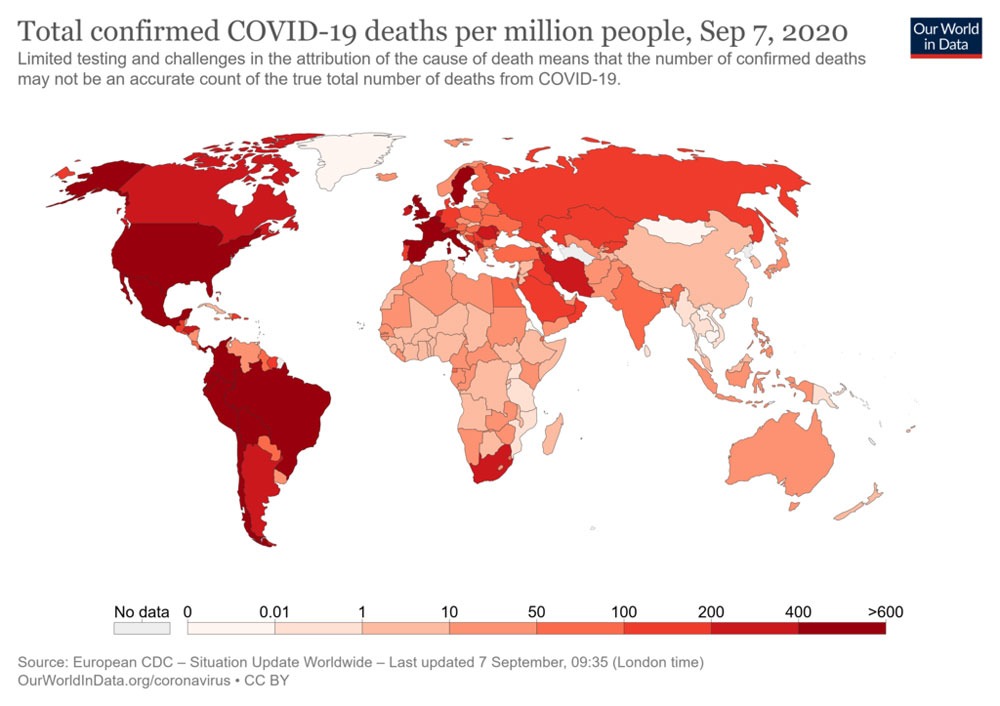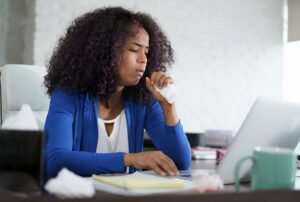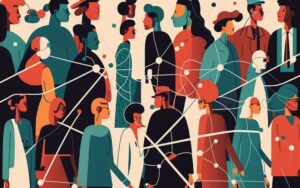
October 26, 2020; Vox
Coronavirus cases are increasing in almost every US state, setting a global record of more than 99,000 cases on October 30th. As thousands suffer, it has been widely reported that a larger percentage of Black and brown lives have been lost this year to the coronavirus, as infection rates for people of color have been higher than for whites.
The dominant narrative supposes that the disproportionate effect of the pandemic on communities of color is simply the tragic outcome or byproduct of racial disparity in the US. But as Phillip Atiba Goff, Amelia M. Haviland, Tracey Lloyd, Mikaela Meyer, and Rachel Warren explain in Vox, racial inequality is also a direct driver of infection and death in the US. And their novel COVID-19 tracking model explains why and how.
Their finding is not altogether surprising. Back in 2009, British epidemiologists Kate Pickett and Richard Wilkinson, in their book The Spirit Level: Why More Equal Societies Almost Always Do Better, found that for “each of eleven different health and social problems: physical health, mental health, drug abuse, education, imprisonment, obesity, social mobility, trust and community life, violence, teenage pregnancies, and child well-being, outcomes are significantly worse in more unequal rich countries.”
The point of Pickett’s and Wilkinson’s study was that inequality doesn’t just kill those of low incomes; instead, what they find is that even the wealthy live less long in more unequal societies, because inequality itself kills. And so, too, this happens to be true in the case of COVID-19, as Goff and his coauthors demonstrate.
“As case numbers and hospitalizations spike across the country,” Goff and his colleagues note that “our inability to protect ourselves and each other is directly tied to our inability to reckon with injustice.”
Up until now, experts, including the Centers for Disease Control and Prevention (CDC) have been attributing the greater number of deaths for people of color to a combination of the following factors:
- Discrimination which “can lead to chronic and toxic stress and shapes social and economic factors that put some people from racial and ethnic minority groups at increased risk for COVID-19”;
- Healthcare access and utilization “can also be limited for these groups by many other factors, such as lack of transportation, childcare, or ability to take time off of work; communication and language barriers; cultural differences between patients and providers; and historical and current discrimination in healthcare systems”;
- Occupation, since “people from some racial and ethnic minority groups are disproportionately represented in essential work settings such as healthcare facilities, farms, factories, grocery stores, and public transportation”;
- Education, income, and wealth gaps “limit future job options and lead to lower paying or less stable jobs…hav[ing] less flexibility to leave jobs that may put them at a higher risk of exposure to the virus that causes COVID-19”; and
- Housing, since some “people from racial and ethnic minority groups live in crowded conditions that make it more challenging to follow prevention strategies.”
Similarly, the Brookings Institution noted in June that “race gaps in vulnerability to COVID-19 highlight the accumulated, intersecting inequities facing Americans of color (but especially Black people) in jobs, housing, education, criminal justice—and in health.”
The model of Goff and his coauthors reorients where systemic racism is located vis-à-vis the pandemic, showing how it drives the current spread: “Racial disparities in our essential systems amplify the risk of infection for everyone, including those who may have imagined themselves as separate from the people behind the climbing casualty figures.”
Using the best data available, they simulated a city of five million to track COVID-19’s spread over 40 days. The model allowed them to calculate how many people comprising the “three essential systems with large racial disparities” were infected and thus infected others: “1) police officers and the people who they come into contact with, 2) people returning home from jail and prisons (known as ‘churn’), and 3) frontline, low-wage workers with no option but to keep showing up.”
Sign up for our free newsletters
Subscribe to NPQ's newsletters to have our top stories delivered directly to your inbox.
By signing up, you agree to our privacy policy and terms of use, and to receive messages from NPQ and our partners.
Their model tracked the pandemic’s spread in a metro area, using national averages for breakdowns among racial groups as reported by the Bureau of Labor Statistics (BLS), Federal Bureau of Investigation (FBI), and the Bureau of Justice Statistics (BJS), taking into account the role of “superspreader” events, call data from police departments regarding officer-civilian interactions, and BJS reports to estimate the numbers of those returning home from jails and prisons.
What the model showed is that their three groups “accounted for roughly 69 percent of new infections.”
Policing and jail/prison churn accounted for 16 percent of the total spread; essential, low-wage work accounted for an additional 53 percent.
Notably, policing and churn contributed to infection rates even among those who had a greater ability to shelter in place. They accounted for 24 percent of the spread among Black residents who could likely stay put, and 17 percent of spread among similar white residents. That means Black people who had not been involved in the criminal justice system were still 40 percent more likely than their white peers to contract the illness from someone who had been.
The model reveals that it is not just within isolated communities of color that the virus spreads but across the entire population of the fictional city, including those members who follow social distancing, mask-wearing, and other restrictive health measures.
In looking at these findings within the context of actual US cities, they estimate that 13–18 percent of new infections across metro areas derive from policing and those returning home from prison, and 50–56 percent of new infections derive from essential, low-wage workers.
“Because of racial inequities,” they claim, “people of every age, socioeconomic status, and race are contracting the virus and dying far more often than they had to.”
Recognizing the magnitude of changing hundreds of years of systemic racial inequity, Goff and his coauthors offer short-term measures to shut down what they call the “engines of misery” amid the pandemic. These range from reducing law enforcement interactions “by suspending traffic enforcement, prioritizing incidents that pose imminent harm over low-level offenses, and issuing warnings in lieu of citations or arrests” to making sure that essential workers have effective personal protective equipment (PPE), frequent testing, the ability to self-quarantine, and sick leave.
Certainly, systemic racism and inequality contribute to deaths and infections in communities of color. But seeing the disproportionate effect as only a byproduct of racism affecting “those over there” propagates a narrative that the effects on Black and brown communities are disconnected from the rising national spread of the virus. As the virus rages across the US, it is time to confront the reality that the health and livelihoods of all of us are inextricably linked to each other.—Beth Couch












